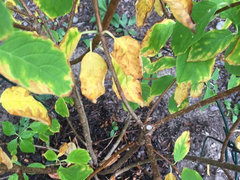All About Hydrangea Leaves Turning Yellow
Wiki Article
More About Hydrangea Leaves Turning Yellow
Table of ContentsThe Only Guide to Hydrangea Leaves Turning YellowWhat Does Hydrangea Leaves Turning Yellow Mean?How Hydrangea Leaves Turning Yellow can Save You Time, Stress, and Money.Hydrangea Leaves Turning Yellow - TruthsHydrangea Leaves Turning Yellow Can Be Fun For AnyoneThe smart Trick of Hydrangea Leaves Turning Yellow That Nobody is Discussing
One possibility is that the plant is not getting sufficient sunlight. Throughout the winter season, the days are shorter, and the sunlight is not as intense, so make certain to put your Hydrangea in an area where it will obtain at least six hours of sunshine each day. One more reason for Hydrangea yellow fallen leaves in winter months could be as well much water.The fallen leaves could be transforming yellow due to temperature level anxiety. Hydrangeas like cooler temperatures, so if the plant remains in a spot that obtains as well hot or too chilly, the fallen leaves will turn yellow. If you assume temperature level stress may be the problem, try moving your Hydrangea to a different place or securing it from the elements with a cloth wrap.

Not known Facts About Hydrangea Leaves Turning Yellow
In the springtime when the mercury stays reasonably reduced, they'll do great. When things heat up over the summer season nevertheless, time invested in the very early mid-day rays can create unimaginable damage.: Expand your hydrangeas in a place where they'll obtain sunshine in the early mornings or nights, but not during the peak hours.Wilting is triggered by absence of dampness, implying there are a couple of great methods to use to stop this from occurring - Hydrangea Leaves Turning Yellow. Offer your hydrangeas a healthy glug of water every few days when the temperatures are climbing up high, and deal with the dirt to better retain moisture. After watering, a bit of mulch around the base of each plant should aid with this by keeping wetness in the soil
:max_bytes(150000):strip_icc()/GettyImages-1286441508-16633f72dd07438ba515bfb08157b9da.jpg)
The Ultimate Guide To Hydrangea Leaves Turning Yellow
As a basic general rule, we advise getting rid of fallen leaves when they are like it 50% brown or greater. While browning triggered by any type of factor can not be reversed, taking the rehabilitative action described above will encourage the plant to expand new leaves so the harmed fallen leaves either drop off normally or can be eliminated by the gardener.Hydrangeas should be sprinkled only when the leading few inches of soil are dry, and should be provided a comprehensive soaking each time. Underwatered hydrangeas are most likely to have yellow, wilting, and sagging leaves.
The method you repair hydrangea leaves turning yellow depends upon the vital issue causing the yellow leaves. This can be hard to determine, but once you do you will have the ability to change your plant treatment accordingly to take care of the trouble. Hydrangea Leaves Turning Yellow. As pointed out in the past, an usual concern with hydrangeas is nutrient shortages
Some Ideas on Hydrangea Leaves Turning Yellow You Need To Know
Throughout the height growing season, you ought to water at a rate of about 1 inch each week. If you are fretted about not appropriately watering your hydrangeas, there are a pair of points you can do. Adding mulch to the base of the plants over the root area aid to control the temperature level around the bush and keep water in the dirt.Alternatively, you can purchase and mount straightforward watering globes. Sprinkling globes hold water in them and gradually release this read this article water right into the soil as the ground ends up being dry. Simply fill the globe with water, stick the spout into the dirt within the root zone near the base of the plant, and leave it in position until all the water is gone.
If it is too severe, some plants will certainly never recoup from transplant shock and will certainly remain to decrease up until they pass away. Lessen transplant shock by consisting of as lots of roots as possible when digging up your plant to relocate it. Make certain to provide even more water than usual in the weeks following planting to assist your plant recover and grow brand-new origins.
The Best Guide To Hydrangea Leaves Turning Yellow

To avoid spreading out fungal illness, be sure to thouroughly tidy and disinfect any kind of trimming devices before and after use. Ultimately, you can attempt to flush the roots with water to get rid of excess fertlizer.
Your hydrangea plant prefers well-drained, moist soil. If the pot has navigate here poor water drainage, or your soil is swamped, the fallen leaves will certainly start to transform yellow. Overwatering makes the soil soggy. Swamped and soaked soil can lead to stunted development, leaf staining, and, worst of all, rot fungal illness. Even though over-watering can be harmful, under-watering is not an alternative either.
If you don't water your hydrangea plant for greater than a week, the leaves will start transforming yellow. Fungal conditions that attack the plants tend to reveal join the origins and the fallen leaves of the plant. One of these diseases is origin rot, that makes it hard for the plant to feed appropriately.
Hydrangea Leaves Turning Yellow - An Overview
Fallen leave spot is an additional fungal illness that can target hydrangea. It results in the fallen leaves turning yellow and the appearance of brownish and purple areas on the fallen leaves.Report this wiki page